


Marcos’ New Politics Nears Mexico’s Newest State: Quintana Roo
“Where exploitation exists, where humiliation exists, where discrimination exists, here you will also find a Zapatista”
By Al Giordano
The Other Journalism With the Other Campaign in Quintana Roo
January 14, 2006
En memoría de Comandanta Ramona
When Zapatista Subcomandante Marcos rolls toward the coastal Caribbean state of Quintana Roo on Saturday, January 14, he’ll be making a pilgrimage that most of the more than 800,000 citizens of this young state – or their parents – made over the past three decades. The majority of the people in this state are migrants. Previously a sparsely populated territory of the Mexican Republic – home to Maya indigenous, farmers and fishermen – a population explosion began the 1970s when the national government decided to turn a sleepy coconut plantation into the international tourist Mecca of Cancún, and converted Quintana Roo into the 31st state. Back then, Cancún counted with 173 citizens. Today the city’s population is half a million plus 27,000 hotel rooms. Those resorts, the shopping malls, restaurants and nightclubs, were constructed and staffed by immigrants from throughout southern Mexico. Many of these workers came from the same land from where Marcos steps out this week: he is only the latest pilgrim to travel the hot, dusty road from Chiapas to Quintana Roo.
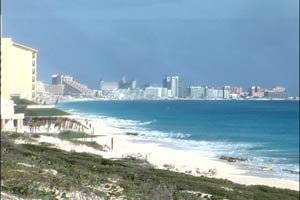 From the Newsreel: Delegate Zero Nears Quintana Roo |
During the four-day visit here by the Zapatista “Delegate Zero” – next Saturday, Sunday, Monday, and Tuesday, beginning in Chetumal – the Maya indigenous farmers of Nicolas Bravo and other towns will present him with the cane of leadership and join forces with the Zapatista “Other Campaign.” Working-class colonists of the Maya Riviera’s Colonia Colosio will ask him for help in their struggle to protect contested land titles from a state government bent on displacing them to make room for wealthy developers. Young people from Cancún will explain their problems – from economic hardship to police repression – to the Subcomandante and will offer their hand in constructing a new way to take political action in what the Zapatistas propose will be a national anti-capitalist campaign, “from below and to the left.” Perhaps even an international tourist or two will come to snap a postcard of the masked Subcomandante and the crowds he is likely to draw: “Vivir Delay-gay-to Zee-roh!” There will certainly be sideshows along the route, but this tour ain’t no Spring Break.
A Land of Immigrants
The reality of the coast of Quintana Roo invokes the hardscrabble road stories of John Steinbeck novels like “The Grapes of Wrath” or “In Dubious Battle,” about the struggles of displaced refugees who flock to a coastal promised land and must learn to organize as workers to defend themselves from abuse and injustice. Although Marcos will have to wait for the month of June to hold his much-anticipated meetings in the border cities of Ciudad Juárez and Tijuana with Mexican immigrants that live in the United States, here in Quintana Roo he will get his first eyewitness glance of (and ear-witness listen to) the phenomenon at the receiving end of Mexican exodus.
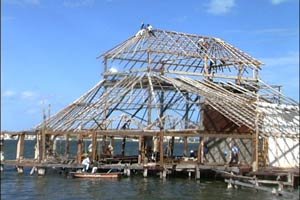 |
“The truth is that in my town there is little pay so we have to come here,” one migrant worker from Chiapas explained to the Other Journalism, during his day off on the beach of Playa del Carmen last Sunday. “I am a construction worker. There are unions here but since we come from out there the union doesn’t mean anything to us. The boss pays us, without healthcare, whatever he wants to pay us. We work from Monday to Saturday, Señor. Today is my day of rest. But at times the authorities don’t take this into account. For us, there is no authority here. We have nothing. Señor, I do it out of necessity because I have a family. I do what the boss asks me to do.”
And what the boss asks him to do is build: the vacationland sprawl extends now two-hours south of Cancún in what promoters call “The Riviera Maya,” a shoreline dotted with all-inclusive resorts, new hotels, theme parks, and other tourist attractions.
“Many people from Cancun are now working in the Riviera while the developers take lands from the indigenous to make hotels,” noted Mauricio Ocampo Ocampo, an organizer with the Other Campaign in Cancún. “This is a strategic point for capital to have factories, labor, water and natural resources here, as well as seek patents on medicinal plants and on the local knowledge which is very rich.”
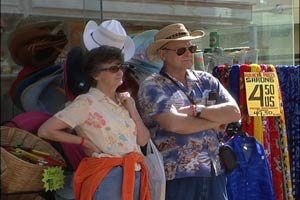 |
One young woman in Playa’s working-class neighborhood of Colonia Colosio told your correspondents: “There are a lot of tourists that come here, the spring breakers. They can do anything they want, break windows, and nobody does anything. They come, they pay, and the police protect them. However, those of us who live here will be brought to jail for any little thing. We who live here don’t have rights, not as youths nor as workers.”
“This has happened to my own son,” says another woman from Colonia Colosio – where half of Playa’s residents now live. “If the youths are drinking a beer the police arrest them. When there are bad guys, the police run away. They don’t confront them. But if they see a poor little drunk they make them pay money and if he doesn’t have money they take him to jail. But if a tourist is drunk they look the other way because he brings dollars.”
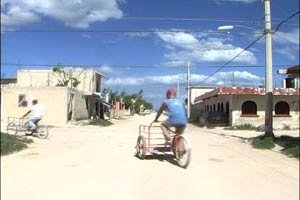 |
But the Zapatista Delegate Zero is likely to find that in all the chaos and hubbub and fast-moving change sweeping through this land there is fertile ground for his mission. In contrast, say, with the political and social stagnancy of the Yucatán capital of Mérida, with its “Divine Caste,” aspiring oligarchs, Catholic overlords, calcified political divisions that go back generations, and the many-layered obstacles to constructing a unified movement there (see “Yucatán Awaits Arrival of Subcomandante Marcos,” Narco News, January 10, 2006), Quintana Roo is a state on the move, anything but static, with a heavy dose of political consciousness among its population similar to that of Mexican immigrants in the United States, or in Mexico City, or, for that matter, recent immigrants anywhere on earth.
Urban Zapatismo vs. Party Politics
The construction boom along Riviera Maya south of Cancún began with the reconstruction from the havoc wreaked by Hurricane Gilbert in September 1988, which, until Hurricane Wilma arrived last October, had been strongest hurricane ever to hit the Atlantic. Speculators and developers took advantage of the displacement caused by the storm and the Riviera Maya went up brick by brick. Construction workers came from throughout southern Mexico and many ended up staying in the region. By the mid-1990s, the number of migrants without homes or land grew to crisis proportions.
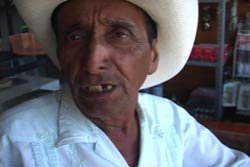 |
Almost twelve years after the first invasion, the residents of Colonia Colosio continue to live in uncertainty. Although then-governor Villanueva granted them titles to their small lots, organized in rectangular blocks and dusty (or muddy) unpaved streets, the governor who entered in 2000, Joaquín Hendricks Díaz, put those titles in doubt. Things have only become dustier and muddier under the current governor Félix Gonzáles Canto: Apocryphal titles from bygone decades have suddenly appeared with the names of wealthy developers making claim to the land underneath thousands of homes in Colosio.
“The lands here are not legalized. They don’t want to give us titles,” a man in a Che Guevara tee-shirt told the Other Journalism video team. “The government doesn’t repair the streets. It doesn’t do anything in the neighborhood.”
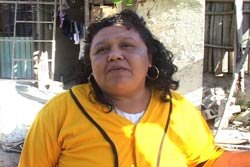 |
Here, in this community of hard knocks, there are big-time developers playing footsie with the PRI government of the state trying to pull the land out from under the residents. There are community “leaders” – also associated with the PRI – claiming to lead the fight to protect the residents in a barrio that was invaded at the urging of the PRI as today the same PRI leads the effort to take away what it once gave.
Now, here comes the “Other Campaign” – an effort that distinctly shuns all political parties and their leaders – and the visit, next Monday, by the masked Subcomandante, with a public meeting scheduled for the sports field in the middle of Colonia Colosio. Last week, organizers distributed 10,000 posters and flyers announcing the event. The mood in the neighborhood upbeat: the possibility for a massive attendance looms. And the overall opinion of community residents about Delegate Zero’s visit is very positive.
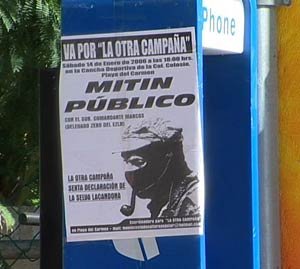 |
“May he come and may he be very welcome,” said a former Chiapas resident named Ezikiel who identifies himself as the president of the Alliance of Workers and Farmers in Solidaridad (the name of the municipality that includes Colosio and Playa del Carmen). He said that, like many immigrants, he arrived in Quintana Roo from Chiapas after the 1982 eruption of the volcano El Chichonal. Ezekiel, interviewed in a pet and farm animal food store, said he is not a member of any political party. “I have a lot of people dependent on me. Nobody has supported them, not the state or federal governments. Many people, campesinos, depend on their little plot of land, but without support, they can’t make it. Who will help them? The state government? The federal? Nobody!”
“He is fighting for a reason and we should give him support,” said one Colosio resident of Marcos’ visit, then qualifying his statement: “Whether it’s him or (presidential candidates Andres Manuel) Lopez Obrador or (Roberto) Madrazo he has a right to receive support. If he has fought in Chiapas he also has a right to come here.”
“How good that they (the Zapatistas) come here because I know that these people fight also for the good of the people, for the wellbeing of us as poor people,” said a man named Oligario. “They don’t fight for the rich. They fight for the poor. For years since they began I knew of their realit. I think it’s great that they are coming here!”
The Two-Edged Sword of Celebrity
Most Colosio residents interviewed by the Other Journalism are enthusiastic about the Subcomandante’s arrival. In some cases, as in much of the Republic, the excitement morphs into fanaticism, the name of Marcos takes on mystical form, and a cult-of-celebrity becomes a two-edged sword for Delegate Zero: It adds to his power to draw crowds, but sometimes distracts from his anti-capitalist political message.
“What’s his name? Marcos! I am an admirer,” said one woman in Colonia Colosio, who claimed (and seemed to believe her own words) that Delegate Zero is practically a Playa beachcomber already: “Well, he’s very handsome. I know him in person… He was in the Hotel de Abby. He is a good person. God-willing, he comes and leads here.”
Similarly, an ex-pat hotel owner from one of the beach tourist towns along this coast contacted local organizers of the Other Campaign. She insisted that they grant her a private meeting with Marcos, also claiming to know him. How? She said she has penned him unanswered love letters for twelve years now.
Also, here along the Riviera Maya, where selling “indigenous” or “shamanic” experiences to gullible tourists is a cottage industry for many mestizos (Mexicans of mixed indigenous and European ancestry) and even some foreigners, various groups and individuals who traffic in such New Age commerce have told (not asked, mind you: told) local organizers that they are coming to do things like “give Marcos a spiritual cleaning” or hold some kind of “ritual ceremony” for him. Similarly, more than a few hotel and restaurant owners and managers have requested that Marcos come to sleep or eat in their establishments to publicize their businesses. Here, in the tourism gold rush, where many have dollars where they once had eyes, some look at Marcos as just another tourist attraction or business opportunity. Add to that some environmentalists that want Delegate Zero to wear a dolphin-head mask in solidarity with their cause, and the Other Campaign, in Quintana Roo, will likely have some very, ahem, other characteristics elbowing in on the simple and humble people who struggle that Marcos comes to meet.
Simple and Humble People Who Fight
Yet there will be no shortage of ordinary people in extraordinary struggle that Delegate Zero will encounter along this coastal path. They include – in this region where a Talking Cross in the ancient Maya center of Chan Santa Cruz (now the town of Felipe Carrillo Puerto, on the road between Chetumal and Playa del Carmen) gave birth to the Caste War of the mid-1800s – many authentic and living Maya indigenous communities bringing their word to the Subcomandante.
Archeologist Fernando Cortés de Brasdefer of the Other Campaign in Chetumal explained to the Other Journalism: “There is a lot of enthusiasm that you can’t see here in the capital city, but in the indigenous communities that are preparing for the 15th. This will be the first time we will see how the country people respond because, unlike the political parties, we are not offering them tortas (snacks), tee shirts, baseball caps or tricks to get them here.”
“Here there coexist various indigenous ethnic groups that have come to Quintana Roo in different epochs,” explains Cortés, one of the local organizers of the Other Campaign. “Some arrived during the (1920s and 30s) era of (Mexican populist president) Lázaro Cárdenas, indigenous people in search of land. And thousands arrived in the 1970s because in order to convert this territory into a state the government needed to have, I think it was, 200,000 residents here. Entire towns from Chiapas, in particular of the Chol ethnicity, are here, awaiting the arrival: Choles, Tzeltales, Tzotziles, also Nahuatls, Totonacos, about twelve ethnic groups in all. And the mestizos, too, are an embattled force. Most have joined political parties, but people of all kinds of ideologies want to listen to the word of the Subcomandante.”
Two hot-button local issues that the visit of Delegate Zero could spark into the national and international limelights await him in southern Quintana Roo. One is the resistance that indigenous communities are putting up to the commercialization of archeological zones. Archeologist Cortés explained: “A large number of people are buying up lands inside archeological zones, including public officials who have come to buy them because they know that this is the most important tourist region and the second most important economic region of the country. The state and federal governments support a law proposed by Fox to allow the private ownership of these lands.”
The other explosive matter in this city on the Belize border is that of the planned expansion of the Chetumal International Airport. The airfield here was constructed during World War II, along with that on the nearby island of Cozumel, both strategic military locations. The indigenous farmers that were kicked off their lands back then were never paid a centavo. The government-planned expansion of the Chetumal airport as part of Plan Puebla Panama (capital’s effort to impose economic control over the natural and human resources and transport routes in Central America and Southern Mexico) is meeting with resistance this time from the indigenous communities. “The campesinos are insisting that this time they be paid a fair price for their lands. This was no easy matter for the previous governor, nor is it for the current one,” notes Cortés.
The capital city of Chetumal has long been a stronghold of the PRI party, but “right now Chetumal is very emotional and enthusiastic, particularly in the Maya regions,” Lorena Romano of the local Other Campaign told us. “Every day more and more are coming together here for the visit.”
“Here,” explained Cortés, “people have felt very threatened by the Príistas. But even the PRI people want to speak with Marcos. They are interested. We think your presence as international press is very important. It supports us morally. Sometimes our lives are threatened. Mine has been. Fortunately the press has been covering all this and right now is not a dangerous moment for us. The common people come near, they bring water and food, and the cities where we least expected response have responded the most. This is a peaceful act. They will have to listen to us because you will be here. Your presence is most important.”
Indeed, one of the possible impacts of Marcos’ visit to this and other regions will be the dissipation of fear, similar to what has occurred in Chiapas since the 1994 rebellion. And there is no limit to the changes that people without fear (or, in Marcos’ parlance, a people who “control their fear”) can create.
The Young Metropolis of Cancún
From the ancient indigenous communities the Other Campaign reaches also toward the young people in the young metropolis of Cancún. In the Rincón Rupestre, a ten-year-old ramshackle cultural center and family home in a working class barrio of Cancún, the Other Journalism found two dozen Other Campaigners busily working at 10:00 p.m. one night to prepare for the visit.
“We are learning a way to do politics ethically where nobody leads,” explained one of the Other Campaign media coordinators, Mauricio Ocampo Ocampo to the reporters. “We are learning to speak and we are learning to listen.”
“We live in a place where there is a lot of wealth and where there also exists a lot of poverty, yet where the salaries are lower than those in the rest of the Republic,” said another young man.
A major theme here in Cancún, as in Playa del Carmen, is unequal treatment under the law and police repression against the locals.
“There are a lot of tourists that come here, the spring breakers,” noted a young woman. “They can do anything they want, even break windows, and nobody does anything. They come, they pay, and the police protect them. However, those of us who live here will be brought to jail for any little thing. We who live here don’t have rights, not as youths nor as workers.”
“Here in Cancún everyone knows where they sell drugs, who sells them, who is involved in land scams,” commented a young man. “The police know, because there are fixes between the police and those who sell. Everyone knows but nobody does anything.”
“This is paradise for pederasts,” commented another on the phenomenon of pedophilia tourism. “They have protection of the police.”
“After the hurricane, many people who live on this side saw their houses fall down,” a young woman spoke up. “The political parties took all the money sent to help them. And they’re going to finally give up the cardboard for roofs that they’ve held back, but this time in exchange for votes.”
The discontent, the anger, the nonconformity, the grievances here in Cancún echo those voiced in every corner of the Republic. And the youths of this cultural center, serious in intent and carefully studying Zapatista communiqués to learn a new way of political action, are as much Mexicans as any other. Mexico – although some Mexicans and foreigners alike don’t seem to want to recognize it – is Cancún and the Riviera Maya, too.
“Where exploitation exists, where humiliation exists, where discrimination exists,” explained Ocampo, “there you will find a Zapatista.”
“The Zapatistas aren’t only those in the jungle,” echoed Cortés of the Other Campaign down the coast in Chetumal. “They are also everyone who doesn’t have a place to sleep, who have nothing to eat, who have nothing to cure themselves with, these are also Zapatistas.”
Click here for more Narco News coverage of Mexico
Lea Ud. el Artículo en Español
Lesen Sie diesen Artikel auf Deutsch
Lisez cet article en français
Legga questo articolo in italiano
- The Fund for Authentic Journalism
For more Narco News, click here.




